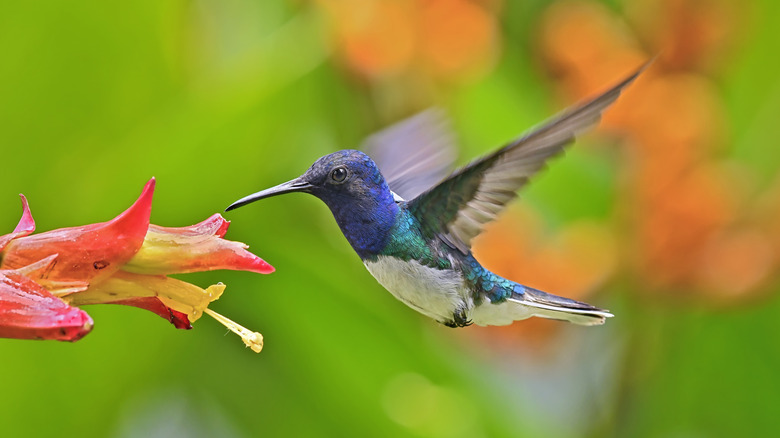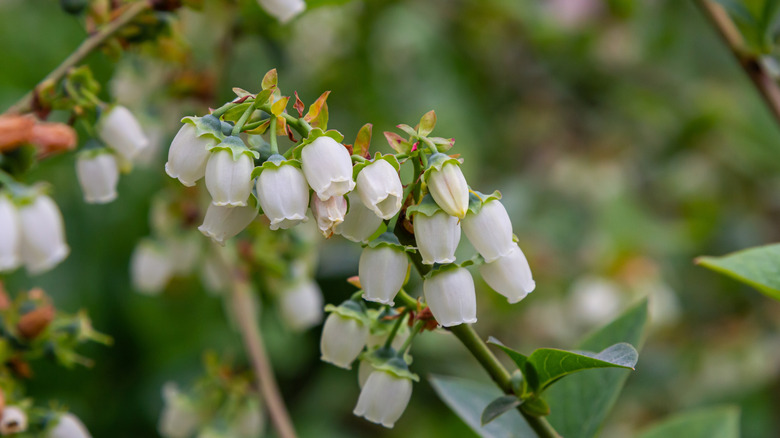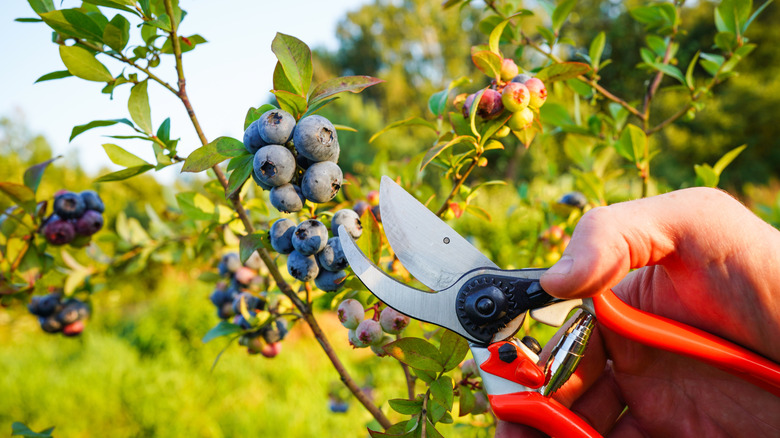Plant This Berried Shrub In The Fall To Attract Hummingbirds Next Spring
When most people think about blueberry bushes (Vaccinium spp.), the fruit tends to get all of the attention. Yet the true magic of this shrub arrives well before any berries, when its early spring flowers emerge as an early nectar source for pollinators. By planting a few shrubs in the fall, you set your garden up for this bloom cycle at exactly the right time. The soil is still warm enough for roots to establish themselves, but the cooler air reduces any transplant stress on your plants. That means, come spring, your shrubs have already done the work underground and are ready to produce clusters of delicate, bell-shaped flowers. For hummingbirds just returning from their migration, that timing is perfect. They arrive in your garden hungry, and your blueberry bushes provide them with the right amount of fuel.
Blueberry flowers aren't the brightest blossoms in the garden, but they certainly make up for it in form and function. The drooping, tubular flowers range from white to soft pink and hang in clusters. The shape is a natural fit for their slender builds, and the nectar concentration is what these birds need to sustain their high metabolism. Depending on the variety and temperature in your region, these flowers can serve as one of the earliest sources of nectar in your spring garden. By making the choice to plant in fall, you're not just investing in fruit for pies and smoothies — you're preparing a springtime stage that transforms your space into a hummingbird haven, where they'll feed and linger, at this seasonal stopover that feels as lively as it does rewarding.
Why blueberry flowers are magnets for hummingbirds
Hummingbirds may be small birds, but they have incredibly high energy needs. Their high metabolism means they must eat almost constantly, which is why nectar-rich flowers can play such a vital role in their survival. Blueberry blossoms are an excellent fit, as they produce the right balance of sugar to keep hummingbirds moving. Even better, these bushes don't just produce a handful of blossoms — they explode with dozens, even hundreds, of flowers in a single season. That sheer abundance creates a multi-week buffet, giving you repeat opportunities to catch a glimpse of these fast, jewel-toned visitors in action. A well-established blueberry patch can support a number of hummingbirds at once, offering plenty of nectar to go around. But if you're looking to attract only a few, one or two bushes may be all you need to get started.
While many people associate hummingbirds with bright red flowers, blueberry blooms prove that subtlety can also be effective. Their pale pink and white color markings make them surprisingly easy for birds to spot. Clusters of blooms form dense, visual beacons, especially when multiple shrubs are planted together. In fact, grouping them in rows or clusters multiplies the appeal, transforming your garden into a natural nectar station. This strategic planting not only attracts hummingbirds but can also support a thriving blueberry yield. Pollination from local hummingbirds — and other pollinators — is essential to turn flowers into berries, and these flying visitors get right to work. You aren't just supporting hummingbirds on their migration: you're creating an eco-friendly garden that enhances berry production in the process.
Caring for a blueberry shrubs while boosting hummingbird appeal
Growing a healthy blueberry plant, hardy in USDA zones 4 through 7, can deliver stunning blooms and sought-after hummingbird visits. You'll want to start by giving them the right environment: full to part sun with acidic, well-drained soil. The pH of your soil should be between 4.5 and 5.5. The bushes should be planted in the fall to provide enough time for roots to develop during colder months, when there will be less competition from weeds and limited temperature-related stress. Mulching around the base of your plant or adding a cover crop like rye can help conserve moisture, suppress any additional weeds, and insulate the roots to protect them from sudden winter freezes. Watering your plants during dry spells is also important, especially during the first two years of growth. Under the right conditions, your blueberry bushes will provide you with more fruit, vibrant blossoms, and an exceptional food source for your local hummingbird populations.
Of course, crafting a hummingbird-friendly garden doesn't just stop with one plant. While blueberry bushes can provide an early nectar source, pairing them with other flowers can extend the hummingbirds' feeding window and attract even more to your yard. Strong companions for blueberries include Columbine (Aquilegia), native azaleas, and bee balm (Monarda didyma). Each of these plants will flower before, during, and just after a blueberry bloom, providing even more food sources for your hummers. With a carefully layered arrangement, you can create a continuous progression of flowers that will bring these small birds back to your garden. Blueberry bushes can become a dependable anchor, while the companion plants bring a vibrant splash of color and variety to your garden.


